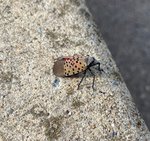

For years, residents in states south of New England have been on a mission to squash the spotted lanternfly (SLF).
For the first time, the winged pest has flown, or hitchhiked, its way to Rhode Island; a single destructive critter has been spotted in Warwick.
The Department of Environmental Management (DEM) announced this week that the SLF, “an exotic pest that targets various plants and trees, has been detected for the first time in Rhode Island.”
“Native to Asia, SLF is most commonly associated with ‘Tree of Heaven’ (Ailanthus altissima) plants and also feeds on a wide variety of agricultural crops such as grape, apple and hops; and several native species of plants and trees including maple, walnut and willow,” according to the DEM.
The DEM circulated a press release Monday warning residents to watch out for the insect.
“A single SLF was found in an industrial/commercial area in Warwick near Jefferson Blvd. and a photo of the insect was sent to DEM through its online agricultural pest alert system,” according to the press release. “DEM’s Division of Agriculture confirmed the sighting on Aug. 2 and is asking the public to report any suspected sightings.”
Residents can report sightings at www.dem.ri.gov/reportspottedlanternfly.
“No known population of SLF is currently present in this area,” according to the DEM. “DEM will be conducting an extensive survey of the area based on US Department of Agriculture (USDA) recommendations to determine if there is any further presence of the invasive insect and will be providing outreach materials to businesses in the area.”
For years, the pest has been spotted in a handful of Mid-Atlantic states, originating in Pennsylvania, and spreading to New Jersey, Maryland, Delaware, and Virginia (with isolated single spotted sightings in New York, Connecticut and Massachusetts).
“In Rhode Island, more than 800 acres of agricultural lands including vineyards, orchards and berry farms are at risk of being infested with SLF, so it’s critical that we take the necessary steps to detect and stop the spread of this invasive pest, particularly since it has now been found in our state,” said Cynthia Kwolek, senior environmental planner and RI CAPS state survey coordinator in DEM’s Division of Agriculture.
In an effort to combat the introduction of SLF to the New England landscape, in 2019, the DEM partnered with the University of Rhode Island (URI), conducting a statewide survey of local vineyards and areas with large populations of “Tree of Heaven” plants.
“Earlier this year and also in 2020, DEM and URI held a series of public workshops to help municipalities, the grower industry, and residents prepare for and respond to this invasive pest, should it be detected in the state,” according to the DEM press release.
The SLF is a unique insect, easily distinguishable from native moths.
“In addition to its spotted patterning, the adult SLF’s unique colors feature scarlet underwings, yellow markings on the abdomen, and tan semi-transparent forewings,” according to the DEM. “Adult lanternflies are about an inch long and are active from August until the first hard freeze, which typically occurs from late October into November.”
It is possible that the sample spotted in Warwick hitched a ride to the Ocean State, according to DEM scientists.
“Although SLF can fly distances on its own, these pests are excellent hitch hikers and mainly spread through human movement,” according to the agency. “Their inconspicuous egg masses can be laid on pallets, vehicles and other goods, so it is important to inspect shipping materials and adhere to travel restrictions when moving through areas that are under quarantine for SLF.”
The Rhode Island DEM offered the following tips to help stop the spread of SLF:
According to the DEM, the species was first detected in Pennsylvania in 2014 and has quickly spread through surrounding states.
“An invasive plant-hopper that is currently infesting portions of the mid-Atlantic region of the United States, SLF has established populations in Pennsylvania, New Jersey, Maryland, Delaware, and Virginia with individual finds in New York, Connecticut and Massachusetts,” according to a DEM press release. “In Pennsylvania, where the pest has been spreading for over six years, there has been significant yield loss in vineyards and the insect has become a public nuisance.”
IF YOU SPOT THIS BUG:
Report a potential finding, please visit: www.dem.ri.gov/reportspottedlanternfly
Comments
No comments on this item Please log in to comment by clicking here